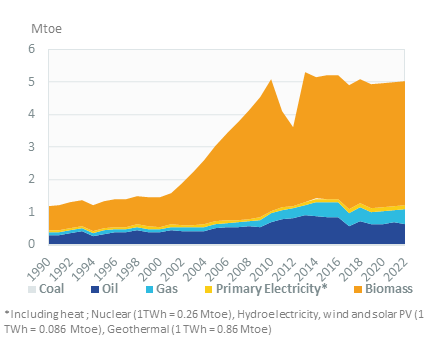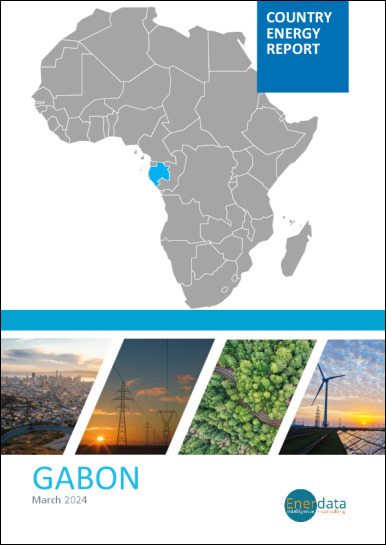- Update
-
- Format
- 3 files (PDF report, 2 Excel files)
- Pages
-
29 (Report only)
- Delivery
- Immediate by e-mail
- GENERAL OVERVIEW
- INSTITUTIONS AND ENERGY POLICY
- ENERGY COMPANIES
- ENERGY SUPPLY
- ENERGY PRICES
- ENERGY CONSUMPTION
- ISSUES AND PROSPECTS
- DATA TABLES
- ABBREVIATIONS
- GLOSSARY
Buy Gabon energy report
Price without VAT. Depending on your statute and location, VAT might be applicable. Get in touch with us for more information.
After validation, you will immediately receive 3 files by email (one pdf report and 2 excel files containing the datasets).
Overview
This analysis includes a comprehensive Gabon energy market report and updated datasets. It is derived from the most recent key economic indicators, supply and demand factors, oil and gas pricing trends and major energy issues and developments surrounding the energy industry. The report provides a complete picture of the country situation, dynamics, current issues and future prospects. With market data and continuous follow-up of markets news, this report brings clear and concise insights with which to tackle national energy challenges and opportunities. Browse the tabs below for a detailed table of contents, the list of graphs and tables, and details on the data files.
Highlights
- Oil represents around 25% of the GDP and around 60% of export earnings.
- Perenco is the main oil producer.
- SEEG holds the monopoly on power production and distribution.
- Hydro and gas have a share of 45% each of the power mix.
- Oil production's long decline has stopped since 2018.
- Total energy consumption increased by 3%/year from 2019 to 2022 and remained stable in 2023.
- Biomass covers around half of this consumption.
- Construction of several hydropower projects is planned but suffering from several years of delays.
- New refining capacities are planned.
- A small LNG export terminal is under construction.
Institutions & Energy Policy
The Ministry of Petroleum and Gas and the Ministry of Energy and Hydraulic Resources share responsibility for the energy sector.
Gabon is the third largest oil producer in Sub-Saharan Africa. Oil represented 25% of the GDP and 56% of total export earnings in 2023.
Energy Companies
Gas:
Perenco dominates natural gas production (average gross production of 50 mcf/d or 0.5 bcm/year) through 5 fields: Ganga, Ozangue, M'Bya, Breme, and Batanga. It supplies the Owendo (Libreville port) and Port-Gentil power stations through a 450 km pipeline.
Energy Supply
Resources:
Gabon is well endowed with energy resources. Proven gas reserves reach 26 bcm (end of 2023) and oil reserves 272 Mt. A large share of the reserves is in deep offshore waters. The hydroelectric potential is amongst the highest of the African continent and is estimated at about 5-6 GW. About 85% of the country is covered by forests (23.5 Mha), a little less than 2/3 of which are exploited.
Energy Prices
Electricity:
Electricity prices for households remained stable in 2024 after a slight increase in 2023 to 20.4 US$c/kWh, following an 11% decrease in 2022 to US$c19.7/kWh; they remained roughly stable before over 2017-2020 (around US$c20/kWh). These prices are more than two times higher than in Cameroon.
Graph: ELECTRICITY PRICES FOR HOUSEHOLDS (US$c/kWh)
Energy Consumption
Energy consumption per capita is around 1.1 toe, including almost 896 kWh of electricity (2023).
Graph: CONSUMPTION TRENDS BY ENERGY SOURCE (Mtoe)

Issues & Prospects
Electricity:
The government wants to reduce the share of oil and gas to 20% and raise the share of hydropower to 80%. Plans will include new power plants, as well as extension projects.
- GRAPH 1: CO2-energy emissions (MtCO2)
- GRAPH 2: Installed electric capacity by source (2023, %)
- GRAPH 3: Gross power production by source (TWh)
- GRAPH 4: Power generation by source (2023, %)
- GRAPH 5: Gasoline & diesel prices (US$/l)
- GRAPH 6: Electricity Prices for Households (US$c/kWh)
- GRAPH 7: Consumption trends by energy source (Mtoe)
- GRAPH 8: Total consumption market share by energy (2023, %)
- GRAPH 9: Final consumption market share by sector (2023, %)
- Economic Indicators: Annual historical data including population, GDP growth, imports and exports, inflation rate, energy security and efficiency indicators, CO2 emissions.
- Supply Indicators: Historical data including oil and gas reserves, electric and refining capacity, energy production, power production and external trade. All are detailed by energy source.
- Demand Indicators: Historical data including consumption per inhabitant, consumption trends, total consumption by energy source, final consumption by energy source and sector, and electricity consumption by sector.
- Energy Balances: Single table displaying the overall energy industry balance per annum, also graphically displayed by energy sub-segment.
- Infrastructure Projects: Covers power plant projects by energy, technology, status and operator.
The Gabon energy market data since 1990 and up to
is included in the Excel file accompanying the Gabon country report.
It showcases the historical evolution, allowing users to easily work with the data.
Key Data included in the excelsheet:
- Economic indicators: Annual historical economic indicators, energy security, energy efficiency and CO2 emissions.
- Supply indicators: Annual historical reserves, capacity, production and external trade (imports(+) exports(-) balance).
- Demand indicators: Annual historical consumption per capita, consumption trends, total consumption, final consumption (per energy and per sector) and electricity consumption total and per sector.
- Energy Balance: total and per energy.
- Gabon Energy Prices: In addition to the analysis provided on the report we also provided a data set which includes historical details on the Gabon energy prices for the follow items: price of premium gasoline (taxes incl.), price of diesel (taxes incl.), price of electricity in industry (taxes incl.), price of electricity for households (taxes incl.), price of natural gas in industry (taxes incl.), prices of natural gas for households (taxes incl.), spot price of Brent and CO2 emissions (from fuel combustion).
 Energy and Climate Databases
Energy and Climate Databases Market Analysis
Market Analysis